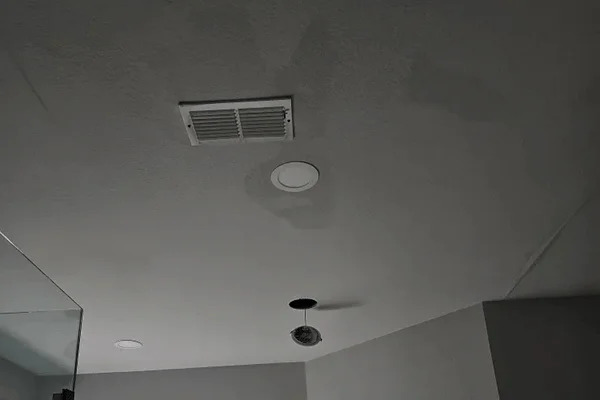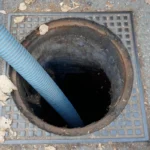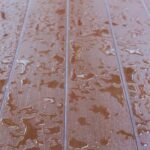You might not think twice about those unsightly water stains on your ceiling, but ignoring them could lead to bigger problems. Often, these stains reveal underlying issues, such as leaky roofs, faulty plumbing, or even condensation from your HVAC system.
Identifying the source early is essential, as it can help you avoid costly repairs and health hazards down the line. So, what should you do when you first notice these stains, and how can you prevent water spots on ceilings from returning? The answers might surprise you.
Common Causes of Ceiling Water Stains
If you’re noticing water stains on your ceiling, quickly identifying the source is essential. Addressing these issues early can save you from costly repairs down the line.
Leaky Roofs After Rain or Storms
Heavy rain or storms can reveal hidden roof issues. Missing shingles, damaged flashing, or clogged gutters often allow water to seep in, leaving stains on your ceiling. These marks shouldn’t be ignored, as they may signal deeper problems. Stay ahead with routine inspections to prevent costly repairs and ceiling water damage before it escalates.
Faulty or Aging Plumbing Pipes
Water spots on the ceiling might not start above the roof—they often stem from leaky, aging pipes. As water escapes from cracks or corrosion, it travels downward and appears as discoloration on the ceiling. Strange dripping sounds or rising water bills are key clues. Regular plumbing checks help avoid hidden leaks and keep your ceilings clean and free from moisture damage.
HVAC and Air Duct Condensation
Condensation from HVAC systems and ducts can quietly damage your ceiling when warm air hits cold surfaces, moisture forms and drips downward. Without proper insulation, this buildup causes noticeable marks on the ceiling. Keeping your HVAC system efficient and sealed can minimize this risk. Regular maintenance is a smart move to protect your home’s structure and air quality.
Overflow from Upstairs Bathrooms or Appliances
Water from overflowing tubs, sinks, or appliances upstairs often stains the ceiling below. Small leaks can quickly turn into big messes if ignored. Watch for pooling water and inspect your fixtures regularly to prevent potential issues. Acting early helps protect against hidden moisture, mold, and costly repairs—all of which can be avoided with routine maintenance and care.
Poor Attic Ventilation or Insulation
Inadequate attic insulation or poor ventilation can trap moisture, causing it to condense and seep into the ceilings below. This can result in unsightly stains that worsen over time. You may notice this more in humid months or after storms. Regularly checking attic airflow and insulation helps prevent moisture buildup, which in turn extends the life of your ceiling and roof materials.
Clogged Gutters and Improper Drainage
When gutters clog, rainwater spills over and can sneak into your home. Improper drainage near your foundation also allows water to pool and eventually seep into ceilings. This often results in persistent stains or peeling paint. Cleaning gutters and ensuring downspouts direct water away from your home helps prevent moisture buildup and keeps your ceilings stain-free.
How to Identify Ceiling Water Stains Early
Stains on your ceiling often begin as faint yellow or brown spots. Spotting them early can help prevent costly repairs and long-term structural damage.
- Yellow or Brown Discoloration: Yellow or brown ceiling water stains indicate moisture problems, often resulting from leaks in plumbing, roofing, or HVAC systems. Early detection helps prevent mold and costly structural damage.
- Peeling Paint or Bubbling Texture: Peeling or bubbling paint on your ceiling typically indicates trapped moisture, often resulting from leaks or inadequate ventilation. Address these signs promptly to prevent further damage and costly repairs.
- Sagging or Softened Ceiling Materials: Sagging or softened ceiling materials indicate water damage that is weakening the structure. Look for discoloration and cracks. Early action prevents further damage and costly structural repairs.
- Musty Smells or Visible Mold Spots: Musty odors or visible mold spots on your ceiling indicate excess moisture and potential leaks. Act quickly to avoid health risks and widespread mold growth.
Dangers of Ignoring Ceiling Water Damage
Ignoring water damage on your ceiling can cause serious health and safety issues. Mold may develop, contaminating the air, and structural problems could weaken your home’s integrity.
Risk of Mold Growth and Air Contamination
Ceiling moisture creates the perfect environment for mold, which can contaminate indoor air. Mold spores spread quickly, often before you notice. Breathing these in may trigger allergies or worsen respiratory issues. If you see signs of water damage, act fast. Preventing mold early is key to maintaining a healthy home and avoiding serious air quality problems.
Structural Damage to Ceilings and Walls
When water infiltrates ceilings or walls, it weakens materials like drywall and wood. Over time, this leads to sagging, cracks, or even collapse. Minor issues left unaddressed can turn into costly structural repairs. Regular inspection helps catch early signs of damage. Don’t wait—addressing concerns early protects your home’s stability and prevents more extensive problems from developing.
Electrical Hazards Behind Ceilings
Ceiling leaks may come into contact with electrical wiring, increasing the risk of short circuits or fires. Water-damaged insulation also becomes a conductor, posing serious safety risks. If you suspect electrical exposure, don’t investigate alone—call a professional for assistance. Prioritize safety and have the affected area inspected promptly to prevent potentially hazardous complications from hidden electrical damage.
Escalating Repair Costs Over Time
Ceiling water damage might seem harmless at first, but delays in addressing them often lead to major expenses. Unchecked moisture can damage insulation, electrical systems, and even structural elements. Early intervention is far more affordable than emergency restoration. Don’t ignore small stains—fixing the problem quickly can save you thousands and preserve your home’s safety.
What to Do If You Notice Water Stains
If you spot water stains on your ceiling, acting quickly is essential. First, stop the source of the water to prevent further damage. Then, document the issue and contact a restoration expert to guarantee proper drying and repairs.
- Stop the Water Source Immediately: Water stains often signal a leak. Check your roof or plumbing and shut off the water source quickly to prevent further damage and mold growth.
- Document the Damage for Insurance: Photograph visible damage and record discovery dates. Save repair receipts and organize all documentation to support your insurance claim effectively and ensure proper compensation.
- Contact a Water Damage Restoration Expert: Call a restoration expert to inspect the damage, locate the source of the leak, and initiate repairs. Their guidance ensures the problem is appropriately addressed and helps with insurance claims.
- Dry and Repair the Affected Area Properly: Remove wet materials, use fans to dry the space, clean the area, and repaint using a stain-blocking primer to prevent recurring issues.
Preventing Future Ceiling Water Stains
You must take a proactive approach to keep your ceilings free of water stains. Regular roof and gutter inspections, plumbing and HVAC system maintenance, and improvements to attic insulation and ventilation can make a significant difference.
Regular Roof and Gutter Inspections
Inspect your roof and gutters at least twice a year to prevent future problems. Missing shingles or clogged gutters often go unnoticed until water stains appear on the ceiling. Clear debris to allow proper drainage. Catching early signs of water damage during seasonal checks helps prevent costly repairs and keeps your home’s structure safe and sound.
Maintain Plumbing and HVAC Systems
Keep plumbing and HVAC systems in top shape to avoid hidden leaks. Small drips can worsen over time, leading to costly repairs. Clear HVAC drains, inspect pipes, and replace worn parts promptly to ensure optimal system performance. Addressing these routine maintenance tasks helps prevent unseen damage and can protect your ceilings from developing stains in the future.
Improve Attic Insulation and Ventilation
Enhance attic insulation and ventilation to stop moisture buildup that causes ceiling water stains. Poor airflow allows humidity to collect, which eventually leads to signs of water damage. Use insulation with a high R-value and ensure vents are unblocked. Proper attic conditions help protect ceilings from dampness and mold while boosting your home’s overall energy efficiency.
Use Mold-Resistant Paint and Materials
Mold-resistant paint and materials can help prevent water stains on your ceiling. These options slow mold growth and are particularly helpful in areas prone to moisture. Before applying, fix the leak and remove any water damage. Choose moisture-resistant drywall or ceiling tiles for extra protection. It’s a simple upgrade that preserves your home’s cleanliness and structural integrity.
Final Thoughts on Ceiling Water Stains in the Home
Use mold-resistant paint and materials to help prevent water stains on your ceiling. Fix leaks first, then apply moisture-resistant paint or install special drywall or ceiling tiles. These upgrades slow mold growth, protect against future damage, and keep your home cleaner and structurally sound, especially in areas prone to dampness or high humidity.
Notice Ceiling Stains? Don’t Wait—Call Our Water Damage Pros Today!









